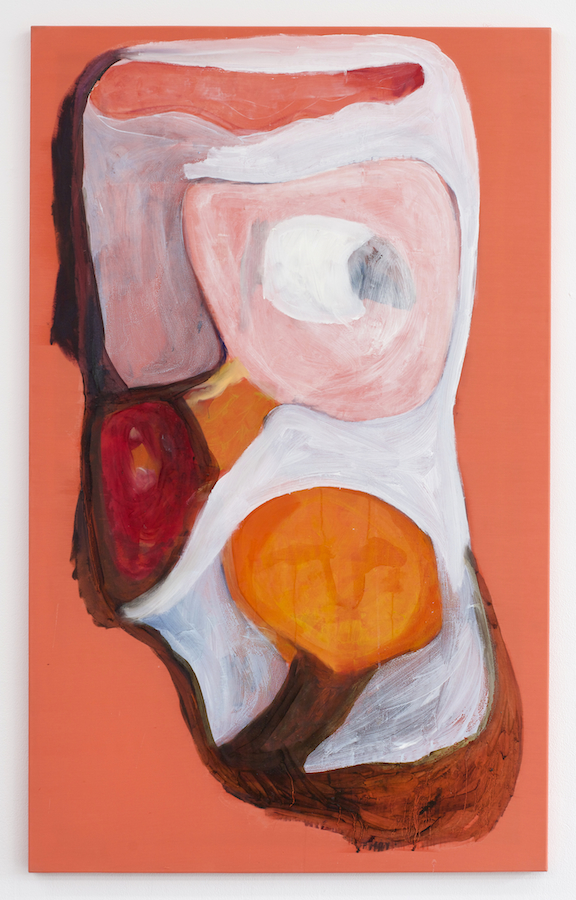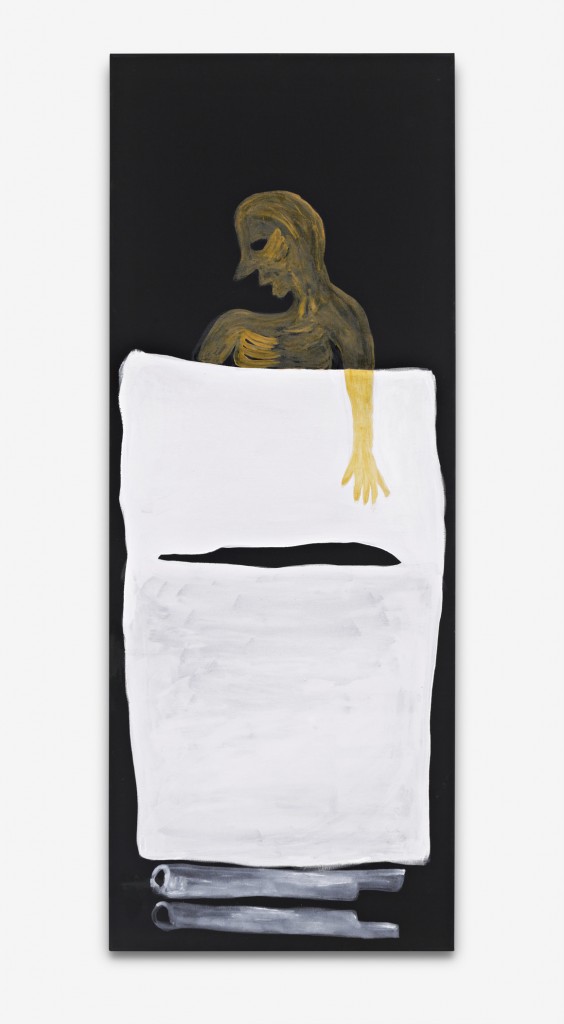Max Schmidtlein, Hallo, 2014 and Head and Shoulders, 2015
Max Schmidtlein’s solo exhibition Detox Plus is a highly contemporary painting exhibition. ‘Not another “contemporary” painting show’, you might say. Yet more painting that wants to do everything differently. Painting that acts oh so aware of media issues and its own implication in the mechanisms of both on- and offline circulation – but in the end turns out to be just that: implicated. While these grumbles may be warranted, perhaps this exhibition is different.
Detox Plus not only looks cheap, it is: made, in fact, on a shoe-string budget. Nine works are on view, eight of them almost the same size and similar in appearance. The longish canvases of thin black fabric (bought on sale at Karstadt, apparently) are used sometimes vertically, sometimes horizontally; all are painted using products from the pharmacy chain dm. The only work that’s not a painting is a deceptively real light box bearing the dm logo, installed outside the gallery (dm, as all works from 2015).
The titles of the works are derived from the respective products used in their manufacture, for example Head and Shoulders, the exhibition’s most representational painting. True to its punning title, the work depicts the head and shoulders of a human figure on a black background, while the body for the most part disappears beneath a white, nearly rectangular spot of colour (made of shampoo and conditioner from the corresponding brand, together with chalk, oil, and acrylic paint). Contrastingly, Balea is almost abstract. The hint of a hand can be made out and one can’t help but search the glittery, slippery-looking splotch for traces of lotions and bath products from the eponymous personal hygiene brand. For Profissimo, a cleaning product from the dm in-store household range was used. The work depicts a kitchen knife and a pack of cigarettes. And in The Beauty Effect, one detects a reclining figure stretching its arms over a head resembling an irregular square on which a mixture of anti-acne cream, essential oils, and perfumed wax has been applied. If you get up close to the canvases, you can even smell the products.
While this might sound like a sequence of cheap one-liners, the target quickly becomes clear. The focus is less the craze for wellness and detox than the current ubiquity of what is largely, ostensibly, conceptual (and for the most part abstract) meta-painting. In other words, the joke works despite the collision of cheap material and cheap concept, not through it. It’s a form of meta-meta-painting, if you like. Perhaps in a similar vein to what the Reena Spaulings pranksters have come up with for their concurrent Later Seascapes show on view at Berlin’s Galerie Neu – four ‘Zombie Formalist’ abstract canvases painted by robot vacuum cleaners. These works, too, are one-liners: a commentary on painting through painting. Whereas by now Reena Spaulings’ project might come across as the self-reflexive one-upmanship of cynical jokes – their subversive aspect lost largely due to the position of power they’ve achieved at the heart of the art establishment – Schmidtlein’s exhibition feels quite different: more the stunt of a mischievous court jester than a grimly nihilistic gesture by the sovereign.
Schmidtlein might make use of the prevailing short-circuit between material and concept, but he intersects it at the formal level by using deliberately sloppy figuration. Rather than a slick, decorative abstraction based on a tired conceptual superstructure – the automatization of a painting process whose insistence on expressivity has long since ceased to be anything more than appearance – here are helpless, sad, ghostly figures that attempt, apparently without much success, to breathe new life into their tired, dirty bodies with cheap synthetic hygiene products. At the same time, and in the midst of all this dreariness, Schmidtlein’s paintings are also far removed from the colourful canvases in which today’s painters have tried to restore figuration through comic form, using googly eyes and cute monsters to poke fun at conveyer-belt abstraction.
Ultimately, Schmidtlein’s show too is a grinning meta-commentary on the ubiquitous genre of conceptual painting. One, however, that doesn’t cynically turn itself into a robo-cleaner messing around with the dirt on the gallery floor, only then to sell that same dirt. Instead these paintings use the mud of a €1.99 face-mask: a kind of fresh-cell therapy in a low-grade drugstore spirit. Lo and behold, beneath it all a young and tender skin actually does appear. What’s the dm slogan that puts it so well? ‘This is where I’m a person, this is where I shop.’ And that’s miles away from painting bots.

